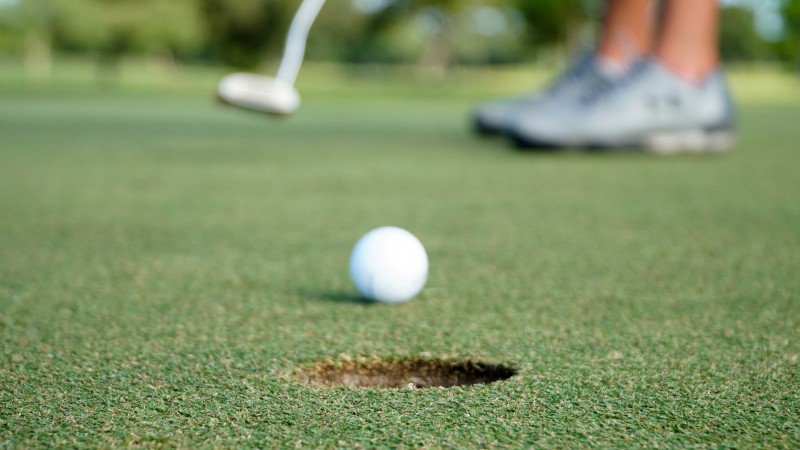As you start to play golf and I mean really play, not the driving range, you quickly realize that you can gain or lose tons of strokes on the green. Great putting can cover up for a lot of other mistakes and conversely, it is impossible to score well if you are constantly 3 or 4 putting.
It can be frustrating when a missed 2-foot putt is the same as a 300-yard drive; both count as one stroke on your scorecard. The good news – everyone can improve their short game and we have come up with 7 putting tips for beginner golfers, these tips are also great for kids who are beginner golfers to help master the greens.
1. Practice Makes Perfect
While having a great putter can help your confidence, there are no shortcuts in golf and very few “naturals”. You improve by spending the time working on your game and the same is true with putting. Before you play a round, make sure you give yourself 15 minutes to warm-up on the practice green. During this time, work on short, medium, and long putts. Learn the speed of the greens you are about to play.
Try to get out to the course once a week for 30 minutes to an hour and only work on your putting. Great putters have superior feel and touch – this is developed by spending time on the practice green.
Cannot get to the course? Bring your putter in your house. You can work on your stroke while putting into a coffee mug on your carpet. Try different surfaces in your house to get different “green” speeds. They key to improving your stroke, putt, drive and chip is repetition, regardless of where you practice. This can help you to be totally prepared for another season.
2. Rock with the Shoulders
You may hear this putting tip said many ways. Use your large muscles, do not get wristy, Rock with the Shoulders, etc. The key to unlock better putting – you do not want your wrist involved in the stroke. This is the most common mistake made by amateur golfers.
To create a quality, consistent putting stroke, you want your shoulders to do the work, not your hands and wrist. Keep them as quiet as possible. Have you ever heard the term “the yips”? This describes when a player starts to flinch at putts with their hands and wrists – you want to avoid this like the plague. If you make a handsy and wristy putting stroke, you can miss a 1-foot putt. Keep them quiet and rock with your shoulders.

3. Learn to Be Still
There should be as little movement in your putting stroke as possible. No head movement. No body movement. Watch Tiger Woods or Steve Stricker hit a putt and focus on their head and body. They look like statues with the exception of their arms.
This tip goes perfectly with #2 – Stay Still & Rock Your Shoulders!
4. Get a Grip
There is no right or wrong way to grip your putter, but there are two fundamentals you should keep in mind.
- You want your hands to be balanced and oppose one another. The easiest way to achieve this is to make sure that both thumbs point down the shaft – avoid getting them twisted to either side.
- Your hands should be connected – you can do this with an overlap or interlock grip, but you want them together with at least one finger.
Beyond those two essentials, go crazy. You can try cross-handed, a finger down the shaft, the claw, oversized grips, it does not matter. If it feels good to you and you make putts, go with it. We would recommend you tinker a little when you practice finding the best grip for you.
5. Relax – No Tension
It is easy to do. You have a putt you really want to make, so you grip the putter a little firmer and increase the tension in your arms. My guess – you miss that putt. A good putting stroke is all about letting the head of the club flow through the golf ball and that is much harder to do with tension in your hands, wrist, and arms.
Try hitting some putts with an extremely soft grip. You can feel the putter head releasing and this is the motion you want during your stroke. The next time you are standing over an important putt, take a moment to relax.

6. Reading is Fundamental
You can make a perfect stroke, but what are the chances the ball finds the hole if you read the break incorrectly? In order to become a good putter, you must learn to read the green. This will not happen overnight, but there are a couple ways to improve.
Use the practice green to work on your reading. Pick a putt, read the break, and hit that putt a few times. Was your read correct? If not, what part of the break did you miss? Did you get the curve correct, but mess up the speed? It is important to remember that reading a putt is about two factors: curve and speed.
The great thing about the game of golf is you get the opportunity to meet and play with different people. Observe their green reading techniques. You will most likely discover great ideas and some that make no sense at all. Do not be afraid to “steal” ideas from your playing partners.
7. Eyes Over the Ball – Putter Flat
Two tips in one, but they directly impact each other. First, when you address the ball on the green, your eyes should be over the ball. You may need to adjust your stance to make this happen.
Second, your putter should lie flat on the ground. The most common mistake is the toe of the club is up in the air. This makes is much more challenging to consistently hit your putts solid. If you leave a putt short, it is quite often because you mishit it.
Getting your eyes directly over the ball and the putter flat will help you more consistently roll the ball on your intended line.

Putting tips for beginners – final thoughts
If you are just getting involved in the game of golf and want to see your scores get lower, improving your short game is the quickest route. Yes, in your junior golf parents preparations you want to practice your full swing on the driving range but working on that putting stroke will help you get more enjoyment from your rounds. Who cares if you hit a few suspect shots if you roll in the 20-foot putt to save par?

